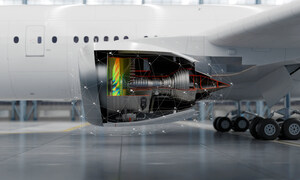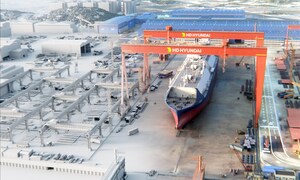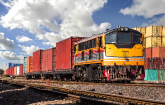U.S. Conference of Mayors Report Details Significant Economic Impact of High-Speed Rail
Four cities studied -- L.A., Chicago, Orlando, and Albany, NY -- could significantly benefit from high-speed rail (HSR) with as many as 150,000 new jobs and some $19 billion in new business revenues created in total.
OKLAHOMA CITY, June 14 /PRNewswire-FirstCall/ -- The U.S. Conference of Mayors today released a new report (www.usmayors.org/highspeedrail) positively assessing the economic impact of high-speed passenger rail along proposed HSR corridors in the United States.
(Logo: http://photos.prnewswire.com/prnh/20070904/SIEMENSLOGO )
The report examined job creation, the effects of improved market access, greater connectivity, travel time savings, as well as increased income and business sales. Study findings show that HSR in the U.S. could significantly increase jobs and business sales if fully implemented as planned by 2035. Higher potential impacts were noted when travel times between cities were reduced to under three hours.
The report, prepared by the Economic Development Research Group and sponsored by Siemens, analyzed the potential economic impact of HSR in the four cities of Los Angeles, Chicago, Orlando and Albany.
New Business, New Jobs
The study also demonstrated that HSR service could help drive higher-density, mixed-use development projects surrounding the stations, ranging from current station additions in Chicago, to new hotel development in Orlando and Albany, as well as additional large-scale developments adjacent to Union Station in Los Angeles. Such local development could help create approximately 30,000 new jobs across these four cities alone.
"Transportation is the backbone of America's economy," explained Tom Cochran, CEO and Executive Director of The United States Conference of Mayors. "Our country cannot successfully compete in the global economy if we fail to invest adequately in our domestic transportation infrastructure, particularly in cities and their metropolitan areas – which underpin so much of our country's economic input. And that investment should include dedicated federal funding for high-speed intercity passenger rail service in the pending authorization of the federal surface transportation law," he continued.
Total new business and job growth projections include:
- In Los Angeles, up to $7.6 billion per year in new business, including $4.3 billion per year in Gross Regional Product (GRP) growth and up to 55,000 jobs.
- In Chicago, up to $6.1 billion per year in new business, including up to $3.6 billion per year in GRP growth and up to 42,000 jobs.
- In Orlando, up to $2.9 billion per year in new business, including up to $1.7 billion per year in GRP growth and up to 27,500 jobs.
- In Albany, up to $2.5 billion per year in new business, including up to $1.4 billion per year in GRP growth and up to 21,000 jobs.
Additionally, HSR's projected larger flow of passengers will lead to increased tourism and business travel, generating additional spending at local hotels, restaurants and retail stores. Projections show that by 2035, HSR can annually add roughly $255 million in the Orlando area; $147 million in the Los Angeles area; more than $100 million in the Albany-Saratoga area; and $42 million in the Chicago area.
Benefits to both Business and the Environment
In addition to significant new business and job growth, the report concludes that HSR service could lead to cost savings for travel time, as well as less road and airport congestion. HSR access will also allow travelers without cars to reach destinations previously only accessible by automobile.
Beyond cost and time savings, HSR will have a positive impact on the environment as each rail car can remove as many as 200 vehicles from the road, producing up to ten times less CO2 per rail trip than the equivalent number of road journeys.
"We have been a global leader in high-speed rail for decades and have seen its economic and environmental benefits realized in other countries," said Oliver Hauck, president of the Mobility division of Siemens Industry, Inc. "By switching to high-speed rail, we not only vastly reduce fuel and carbon dioxide emissions, but also improve traffic flow, ultimately reducing America's annual fuel use. Our calculations show that just in the four cities studied, a high-speed rail system would reduce annual carbon emissions for intercity travel by 2.8 million tons a year. This translates to a reduction of more than one-third of the total carbon currently generated by intercity travel in the four cities."
Increasingly Transparent Borders Broaden Labor Markets
Results also point to an increased economic payback when travel time between cities is cut to less than three hours. Shorter commuting times give businesses greater access to more workers with specialized skills while workers gain access to more employment opportunities.
"These expanded markets offer important new opportunities, especially in an era of flexible work schedules where daily commutes are not required," explained Cochran. "High-speed rail will push back the borders that currently exist for commuters and widen the talent pool available to work in a particular market."
In Los Angeles, high-speed trains are expected to increase commuting options from outlying areas such as Palmdale and business trips from the Central Valley and San Diego. In Orlando, they will enable commuting from the Lakeland area and day trips from Tampa and in Chicago from the Milwaukee area and day trips from cities such as Madison. Finally, in Albany, faster trains can bring the local area within the range of a commute, or an easy one-day business day trip to New York City.
The report also revealed that the availability of HSR will prove beneficial for communities considered to be technology clusters by enhancing day-trip links between R&D and university research centers as well as sites where advanced products are produced.
About the Report
This report, conducted from January through May of 2010, assessed high-speed intercity Passenger Rail's economic impact on the city, metropolitan, and regional economies. It examined job creation, the effects of improved market access, greater connectivity, work-related travel time savings as well as increased income and business sales. The full report can be accessed at usmayors.org/highspeedrail.
About the U.S. Conference of Mayors
The U.S. Conference of Mayors is the official nonpartisan organization of cities with populations of 30,000 or more. There are 1,204 such cities in the country today. Each city is represented in the Conference by its chief elected official, the mayor. More information about the Conference is available at usmayors.org.
About Siemens
Siemens AG (NYSE: SI) is a global powerhouse in electronics and electrical engineering, and operates in the industry, energy and healthcare sectors. For more than 160 years, Siemens has built a reputation for leading-edge innovation and the quality of its products, services and solutions. With 405,000 employees in 190 countries, Siemens reported worldwide revenue of $104.3 billion in fiscal 2009. With its U.S. corporate offices in New York City and Washington, D.C., Siemens in the USA reported revenue of $21.3 billion and employs approximately 64,000 people throughout all 50 states and Puerto Rico. For more information on Siemens in the United States, visit www.usa.siemens.com
About EDR
Economic Development Research Group, Inc. (EDR Group) provides consulting and software solutions for evaluation of economic impacts and development opportunities. EDR Group was started in 1996, with a core group of economists and planners who had previously worked together in various combinations for over ten years. The firm was incorporated in Massachusetts in 2000. For more information, please visit www.edrgroup.com
SOURCE Siemens
WANT YOUR COMPANY'S NEWS FEATURED ON PRNEWSWIRE.COM?
Newsrooms &
Influencers
Digital Media
Outlets
Journalists
Opted In






Share this article